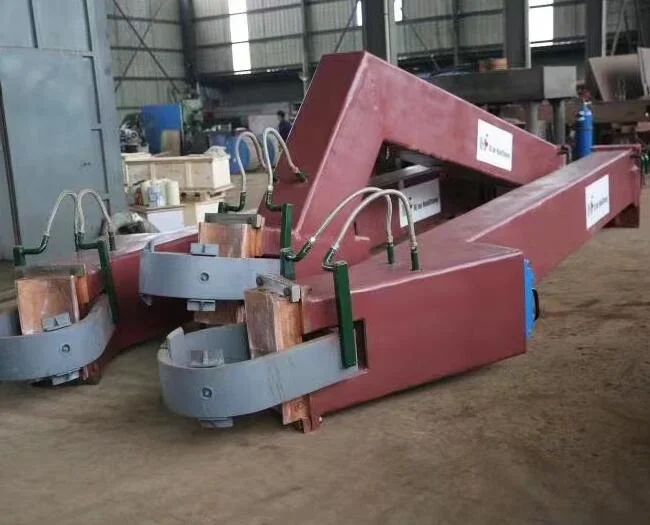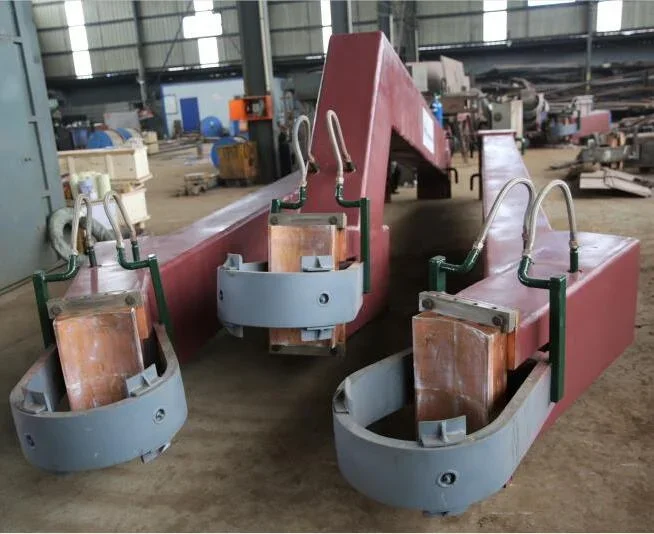In the demanding and highly specialized world of industrial manufacturing, the power conducting arm is a crucial component that often goes unnoticed but plays a vital role in ensuring the efficiency and longevity of electric arc furnaces (EAFs) and ladle furnaces (LFs). This blog article aims to provide a comprehensive guide on how to choose the right power conducting arm for your specific application, covering key considerations, materials, design features, and industry applications.
Understanding the Power Conducting Arm
A power conducting arm is a critical component in electric arc furnaces and ladle furnaces, serving as a clamping device for the electrodes. Its primary function is to conduct electricity from the power source to the electrodes, facilitating the melting process in steel plants, ferroalloy plants, and calcium carbide plants. The design and materials used in power conducting arms directly impact their performance, durability, and overall efficiency.

Key Considerations When Choosing a Power Conducting Arm
1. Material Selection
The materials used in the construction of power conducting arms are critical to their performance. Copper is the most commonly used material due to its excellent electrical conductivity and thermal conductivity. Copper-clad steel is another popular choice, combining the strength of steel with the conductivity of copper. When choosing a power conducting arm, consider the following:
Electrical Conductivity: Copper is the gold standard for electrical conductivity, ensuring minimal power loss and efficient energy transfer.
Thermal Conductivity: High thermal conductivity is essential for dissipating heat generated during the melting process, preventing overheating and extending the arm's lifespan.
Durability: Steel provides the necessary strength and durability to withstand the harsh conditions of industrial furnaces.
2. Design Features
The design of the power conducting arm affects its ease of maintenance, efficiency, and overall performance. Key design features to consider include:
Accessibility for Inspection and Repairs: The clamping device should be easily accessible for regular inspections and quick repairs. This reduces downtime and maintenance costs.
Quick Release Mechanism: In the event of electrode breakage or arcing, the clamp ring should be quickly removable to facilitate rapid repairs and minimize production delays.
Water Cooling System: An internal water cooling system is essential for maintaining optimal temperatures and preventing overheating. Ensure that the cooling system is well-designed and easy to maintain.
Terminal Connections: The terminal connections for the cables should be made of forged copper sections, allowing for seamless integration with existing power cables without modifications.
Electrode Shoe Design: The electrode shoe should have a flat connection to the arm body, simplifying alignment and reducing replacement costs. Water-cooled electrode shoes made of forged copper with bored cooling channels are ideal for efficient heat transfer.
3. Industry Applications
Power conducting arms are widely used in various industries, each with specific requirements. Understanding your industry's unique needs will help you choose the right arm for your application:
Steel Plants (EAF, LF): These plants require power conducting arms with high electrical conductivity and thermal management capabilities to handle the intense heat and power demands of steel production.
Ferro Alloy Plants: These plants produce alloys such as ferromanganese and ferrosilicon, requiring power conducting arms that can withstand high temperatures and corrosive environments.
Calcium Carbide Plants: Calcium carbide production involves high temperatures and electrical demands, necessitating power conducting arms with robust cooling systems and durable materials.
Furnace Manufacturers: Custom-designed power conducting arms may be required to meet the specific needs of different furnace designs and applications.
The Importance of Copper Cladding
Copper cladding is a key feature of many power conducting arms, offering several advantages:
Preventing Lamination: Copper cladding ensures that there is no lamination in the material, which can lead to electrical resistance and reduced efficiency.
Enhanced Conductivity: The copper layer provides excellent electrical conductivity, ensuring efficient power transfer and minimal energy loss.
Durability: Copper-clad steel combines the strength of steel with the conductivity of copper, creating a durable and efficient component.

Water Cooling Systems
Effective thermal management is crucial for the longevity and performance of power conducting arms. Water cooling systems are commonly used to dissipate heat generated during the melting process. Key considerations for water cooling systems include:
Internal Water Channels: Ensure that the arm body has internal water channels designed to provide uniform cooling.
Flanged Water Connections: Flanged connections make it easy to maintain and replace water supply lines, ensuring continuous cooling.
Maintenance Accessibility: The water cooling system should be easily accessible for regular maintenance and inspection to prevent leaks and ensure optimal performance.
Conclusion
Choosing the right power conducting arm for your application involves careful consideration of material selection, design features, and industry-specific requirements. Copper-clad steel arms with robust water cooling systems and easy maintenance access are often the best choice for demanding industrial applications. By selecting a power conducting arm that meets your specific needs, you can ensure efficient energy transfer, reduced downtime, and extended equipment lifespan, ultimately contributing to a more productive and cost-effective manufacturing process.
Timonic (Suzhou) Technology Co., Ltd ( Timonic ), a subsidiary of China Special Metal Group Limited (CSM), we commit to the development and production of new energy lithium battery material production equipment: lithium battery copper foil foil machine, cathode roll, especially focusing on providing one-station for high-quality lithium battery copper foil plant design scheme, mechanical and electrical intelligent equipment, software and hardware systems and automation equipment customization and complete sets and technical services.
Welcome to inquiry if you need to know more about Power Conducting Arm details or order wholesale.
